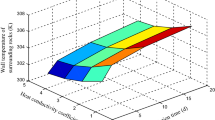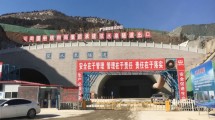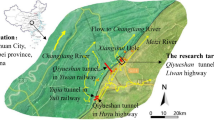Abstract
Thermal hazards of the surrounding rock of subway tunnels are becoming apparent, in which the heat transfer in the surrounding rock plays a crucial role. Due to the shallow buried depth, the subway tunnel encounters a more complicated heat exchange under the duplicate effects of periodic temperature fluctuation of ground atmosphere and periodic temperature variation of tunnel wind, but this issue has not been fully addressed. In this work, a transient heat transfer model of tunnel surrounding rock based on dual periodic temperature boundaries was established. A solver was developed to estimate the temperature rise and heat transfer of surrounding rock. The correctness of this model was then verified by comparing with previous empirical values and semi-empirical equations. The results show that the temperatures of the surrounding rock at different depths still fluctuate following the simple harmonic waves, and there are some regions that are heavily affected by the duplicate effects, such as the overlying strata of the tunnel. The surrounding rock generally exhibits heat storage in annual cycle, but the total heat storage decreases year by year until it tends to stabilize. Furthermore, the shallower the tunnel is buried, the greater the influence of ground temperature and the higher the temperature rise in the tunnel surrounding rock. This research provides an alternative approach to determine the heat storage of tunnel surrounding rock and evaluates the process of thermal disaster manifestation of subway.











Similar content being viewed by others
Data availability
All data generated or analyzed during this study are included in this published article.
References
Adil Zainal O, Yumruta R (2015) Validation of periodic solution for computing CLTD (cooling load temperature difference) values for building walls and flat roofs. Energy 82:758–768
Alkhaier F, Flerchinger GN, Su Z (2012) Shallow groundwater effect on land surface temperature and surface energy balance under bare soil conditions: modeling and description. Hydrol Earth Syst Sci 16:1817–1831
Ampofo F, Maidment G, Missenden J (2004) Underground railway environment in the UK Part 1: Review of thermal comfort. Appl. Therm. Eng. 24:611–631
Ampofo F, Maidment G, Missenden J (2004) Underground railway environment in the UK Part 2: Investigation of heat load. Appl. Therm. Eng. 24:633–645
Barla M, Di Donna A, Perino A (2016) Application of energy tunnels to an urban environment. Geothermics 61:104–113
Bogdanovská G, Molnár V, Fedorko G (2019) Failure analysis of condensing units for refrigerators with refrigerant R134a, R404A. Int J Refrig 100:208–219
Dong Z, Qin Y, Wu J, Guo K (2019) Experimental analysis on temperature field variations of heterogeneous surrounding rock under the condition of periodically changing mine ventilation. Energy Sources Part A: Recov Utiliz Environ Effects 43:1869–1879
Feng Q, Jiang BS, Zhang Q, Wang G (2016) Reliability research on the 5-cm-thick insulation layer used in the Yuximolegai tunnel based on a physical model test. Cold Reg. Sci. Tech. 124:54–66
Gow LJ, Barrett DJ, O’Grady AP, Renzullo LJ, Phinn SR (2018) Subsurface water-use strategies and physiological responses of subtropical eucalypt woodland vegetation under changing water-availability conditions. Agricult Forest Meteorol 248:348–360
Hu ZH, Li XZ, Zhao XB, Xiao L, Wu W (2008) Numerical analysis of factors affecting the range of heat transfer in earth surrounding three subways. J China Univ Min Technol 18:67–71
Insana A, Barla M (2020) Experimental and numerical investigations on the energy performance of a thermo-active tunnel. Renew. Energy 152:781–792
Jenkins K, Gilbey M, Hall J, Glenis V, Kilsby C (2014) Implications of climate change for thermal discomfort on underground railways. Transp Res Part D: Transp Environ 30:1–9
Ji YZ, Tu GB, Sun L (2001) Discussion on energy saving method of underground railway environmental control system. Shandong Build Mater 22:29–31
Jiang B (2018) Research on air temperature of metro tunnel during the initial stage. Urban Rapid Rail Transit 31:113–118
Jin X, Zhang XS, Cao YR, Wang G (2012) Thermal performance evaluation of the wall using heat flux time lag and decrement factor. Energy Build. 47:369–374
Jin H, Yu KW, Gong QM, Zhou SH (2018) Load-carrying capability of shield tunnel damaged by shield shell squeezing action during construction. Thin-Walled Struct. 132:69–78
Jun KJ, Hwang YC, Yune CY (2017) Field measurement of temperature inside tunnel in winter in Gangwon, Korea. Cold Reg. Sci. Tech. 143:32–42
Ke MT, Cheng TC, Wang WP (2002) Numerical simulation for optimizing the design of subway environmental control system. Build. Environ. 37:1139–1152
Krasyuk AM, Lugin IV, P’yankova AY (2015) Delineation of soil body area exposed to thermal effect of subway stations and tunnels. J Min Sci 51:138–143
Li YA, Gao YN, Yang ZJ, Liu XL (2011) Study on change regularity of air temperature underground tunnel based on intermittent operating of heat pump. Appl Mech Mater 90–93:1671–1674
Li XZ, Xiong ZY, Qiao HJ, Ma J, Zhang XH, Du J (2012) Monitoring and analysis of heat transfer through surrounding rocks of subway tunnel. Chin J Undergr Space Eng 8:105–110
Li Z, Chen C, Pan S, Yan L, Li K (2015) The effective use of the piston effect, natural cold sources, and energy saving in Beijing subways. Adv Mech Eng 5:371785
Li B, Han ZW, Bai CG, Hu HH (2019) The influence of soil thermal properties on the operation performance on ground source heat pump system. Renew. Energy 141:903–913
Liang B, Zhao NY (2011) A study on temperature distribution of surrounding rock and mechanical characteristics of lining of Monglian tunnel under high geothermal. Int Conf Civil Eng Build Mater (CEBM) CHINA 255–260:2594–2600
Liu W, Qin Y (2017) Multi-physics coupling model of coal spontaneous combustion in longwall gob area based on moving coordinates. Fuel 188:553–566
Mao YHF, Liu HX (1993) The heating value and load calculation for the subway. J Tunn Translat 8:16–25
Ogunleye O, Singh RM, Cecinato F, Chan Choi J (2020) Effect of intermittent operation on the thermal efficiency of energy tunnels under varying tunnel air temperature. Renew. Energy 146:2646–2658
Ou YQ, Jiang Y, Zhu YX, Zhao B (2002) Research about the critical ventilation speed on the blocking working condition of metro tunneling section (I). Metro Light Rail 2:34–41
Pitilakis K (2009) Seismic design of shallow immersed tunnels and underground metro stations. International Conference on Performance-Based Design in Earthquake Geotechnical Engineering, Tokyo, JAPAN pp. 239-240.
Qin YP, Jia JY, Liu W, Yang XB (2013) Four finite volume schemes for heat transfer problems. J Liaoning Tech Univ 32:763–767
Qin YP, Song HT, Wu JS, Bai YX, Dong ZY, Ye F (2015) Analysis of surrounding rock heat dissipation for trapezoid roadway by finite-volume method. J Liaoning Tech Univ 34:898–904
Qin YP, Song HT, Wu JS, Dong ZY (2015) Numerical analysis of temperature field of surrounding rock under periodic boundary using finite volume method. J China Coal Soc 40:1541–1549
Revesz A, Chaer I, Thompson J, Mavroulidou M, Gunn M, Maidment G (2016) Ground source heat pumps and their interactions with underground railway tunnels in an urban environment: A review. Appl. Therm. Eng. 93:147–154
Shi CH, Cao CY, Lei MF (2017) An analysis of the ground deformation caused by shield tunnel construction combining an elastic half-space model and stochastic medium theory. KSCE J. Civ. Eng. 21:1933–1944
Strub F, Castaing-Lasvignottes J, Strub M, Pons M, Monchoux F (2005) Second law analysis of periodic heat conduction through a wall. Int. J. Therm. Sci. 44:1154–1160
Sun C, Shu SM, Ding GZ, Zhang XQ, Hu XH (2013) Investigation of time lags and decrement factors for different building outside temperatures. Energy Build. 61:1–7
Tan XJ, Chen WZ, Yang DS, Dai YH, Wu GJ, Yang JP, Yu HD, Tian HM, Zhao WS (2014) Study on the influence of airflow on the temperature of the surrounding rock in a cold region tunnel and its application to insulation layer design. Appl. Therm. Eng. 67:320–334
Tong L, Hu ST, Lu S, Wang YM (2019) Study on heat transfer performance of metro tunnel capillary heat exchanger. Sust. Cities Soc. 45:683–685
Tong Z, Cao T, Zang G, Hu S, Liu G, Wang Y (2020) Performance analysis of capillary front-end heat exchanger for subway tunnel. Appl Therm Eng 174:115360
Tong LH (2005) Study on energy saving control of thermal environment of Beijing Metro Line 1 and 2. The 13th National HVAC Technical Information Network Technology Exchange Conference, China, pp. 435-440
Transportation USDo (1975) Subway environmental design handbook—V.1—Principles and applications.
Unver B, Agan C (2003) Application of heat transfer analysis for frozen food storage caverns. Tunn. Undergr. Space Technol. 18:7–17
Wang Y, Li XF (2018) STESS: subway thermal environment simulation software. Sust. Cities Soc. 38:98–108
Wang ZM, Zhang W, Lei CZ, Ding PL, Sun K (2014) Numerical prediction of the long-term soil temperature variations around shallow sections of cross-river road tunnels. J Southeast Univ 30:480–488
Wang YC, Feng HR, Xi XY (2017) Monitoring and autonomous control of Beijing Subway HVAC system for energy sustainability. Energy Sustain Dev. 39:1–12
Wu W, Li XZ, Hu ZH, Xiao L (2008) Calculating methods of heat transfer quantity through surrounding rocks in metro design. Chin J Undergr Space Eng 4:89–93
Xiaozhao L, Zhiyong X, Hengjun Q, Juan M, Xuehua Z, Maojin D (2012) Monitoring and analysis of heat transfer through surrounding rocks of subway tunnel. Chin J Undergr Space Eng 8:105–110
Xu TY, Wang MN, Yu L, Lv C, Dong YC, Tian Y (2019) Research on the earth pressure and internal force of a high-fill open-cut tunnel using a bilayer lining design: a field test using an FBG automatic data acquisition system. Sensors. 19:1487–1505
Xu ZG, Du XL, Xu CS, Hao H, Bi KM, Jiang JW (2019) Numerical research on seismic response characteristics of shallow buried rectangular underground structure. Soil Dyn. Earthq. Eng. 116:242–252
Xu ZH (2002) Determination of air conditioning loads and the loads analysis of ice storge system in subway. Refrigeration & Air-condition 01:11–14
Yu WB, Lu Y, Han FL, Liu YZ, Zhang XF (2018) Dynamic process of the thermal regime of a permafrost tunnel on Tibetan Plateau. Tunn. Undergr. Space Technol. 71:159–165
Yuan YP, Gao XK, Wu HW, Zhang ZJ, Cao XL, Sun LL, Yu NY (2017) Coupled cooling method and application of latent heat thermal energy storage combined with pre-cooling of envelope: Method and model development. Energy 119:817–833
Zhang Y, Li XF (2018) Heat transfer formalism using GFM and FEM in underground tunnels. Build Environ 143:717–726
Zhang Y, Li XF (2019) Response-surface-model based on influencing factor analysis of subway tunnel temperature. Build. Environ. 160:106140
Zhang Y, Li X (2020) Monitoring and analysis of subway tunnel thermal environment: a case study in Guangzhou, China. Sust. Cities Soc. 55:102057
Zhang GZ, Xia CC, Sun M, Zou YC, Xiao SG (2013) A new model and analytical solution for the heat conduction of tunnel lining ground heat exchangers. Cold Reg. Sci. Tech. 88:59–66
Zhang H, Zhu CG, Zheng WD, You SJ, Ye TZ, Xue P (2016) Experimental and numerical investigation of braking energy on thermal environment of underground subway station in China’s northern severe cold regions. Energy 116:880–893
Zhang H, Cui T, Liu MZ, Zheng WD, Zhu CG, You SJ, Zhang YZ (2017) Energy performance investigation of an innovative environmental control system in subway station. Build. Environ. 126:68–81
Acknowledgements
We appreciate the Editor’s efforts and the anonymous reviewers who provided valuable comments and suggestions on our research.
Funding
This study was supported by the National Natural Science Foundation of China (Grant numbers 52074303, 51874315) and the China Postdoctoral Science Foundation (Grant numbers 2018M630183).
Author information
Authors and Affiliations
Contributions
WL: conceptualization; methodology; writing—review and editing; funding acquisition. SL: formal analysis; validation; writing—original draft preparation. QH: data curation; formal analysis; writing—review and editing; investigation. YQ: project administration; visualization; supervision. All authors read and approved the final manuscript.
Corresponding author
Ethics declarations
Ethics approval and consent to participate
Not applicable.
Consent for publication
Not applicable.
Competing interests
The authors declare no competing interests.
Additional information
Responsible Editor: Philippe Garrigues
Publisher's note
Springer Nature remains neutral with regard to jurisdictional claims in published maps and institutional affiliations.
Rights and permissions
About this article
Cite this article
Liu, W., Liang, S., Huang, Q. et al. Estimation of thermal hazards in surrounding rock of subway tunnel under dual periodic temperature boundaries: a case study. Environ Sci Pollut Res 29, 67063–67075 (2022). https://doi.org/10.1007/s11356-022-20370-3
Received:
Accepted:
Published:
Issue Date:
DOI: https://doi.org/10.1007/s11356-022-20370-3




